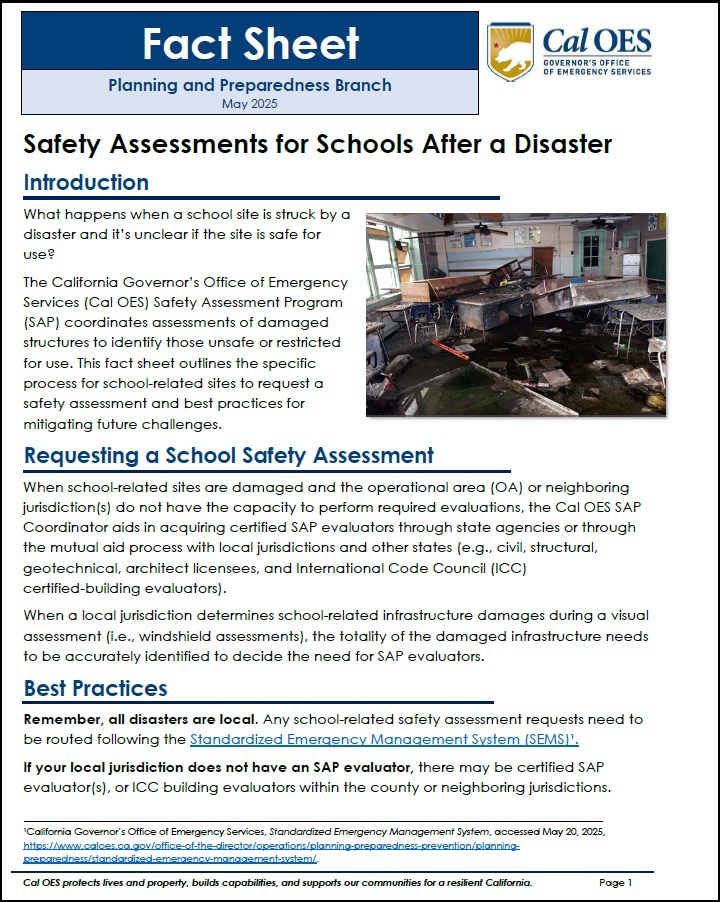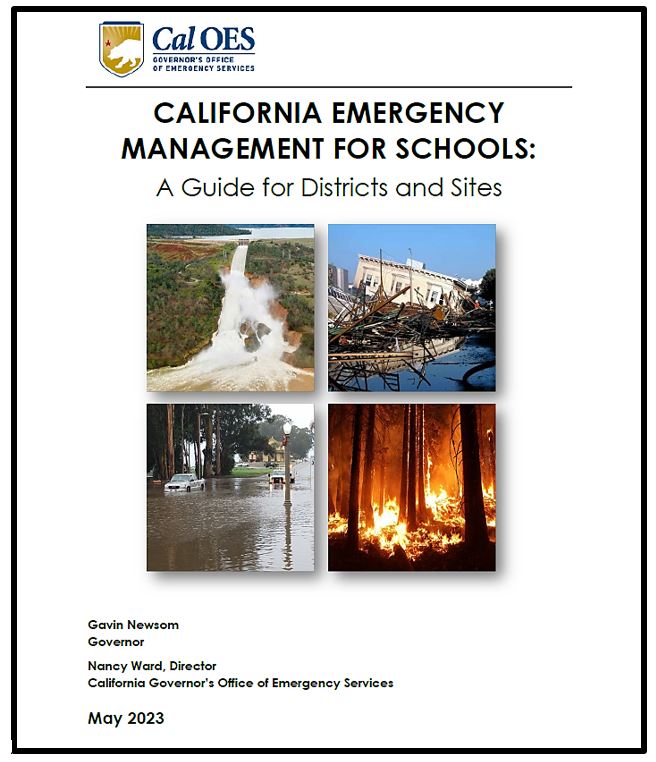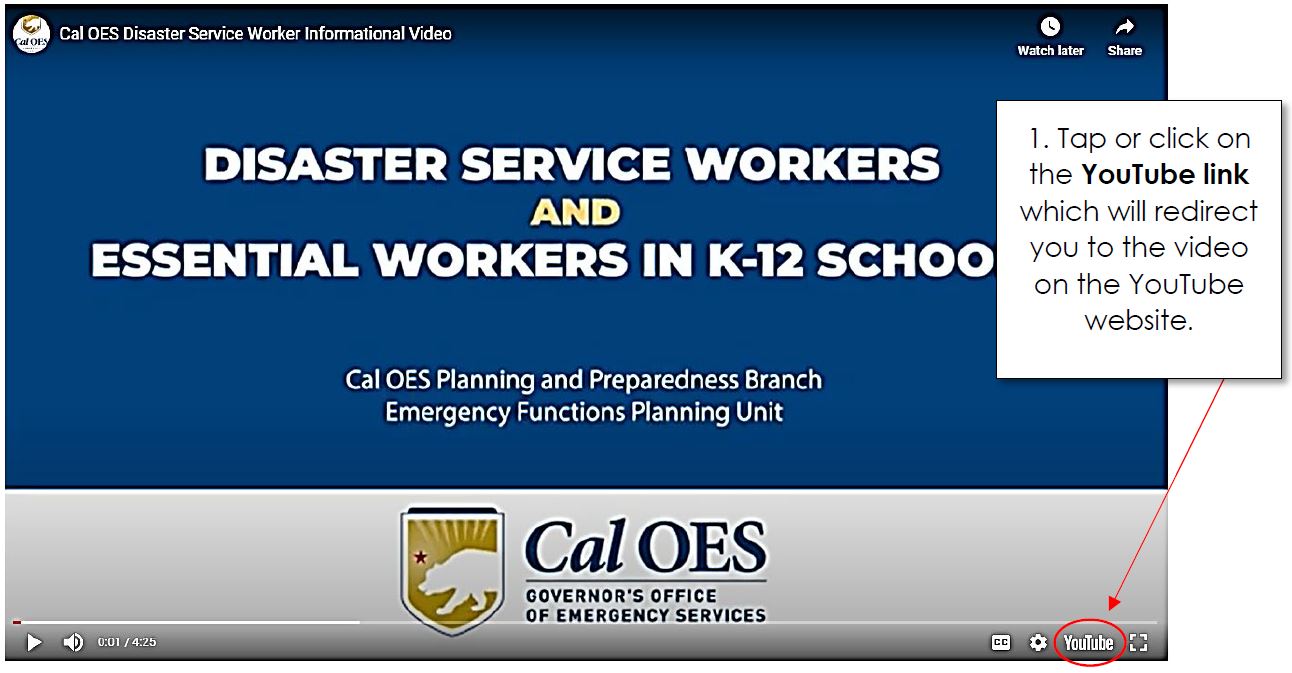School Emergency Planning & Safety

FOR SCHOOLS & SCHOOL-RELATED SITES AFFECTED BY DISASTERS: New Safety Assessment Program (SAP) Fact Sheet
 The Safety Assessments for Schools After a Disaster Fact Sheet outlines the specific process for school-related sites (county offices of education, school districts, and schools) to request a safety assessment, and best practices for mitigating future challenges. The Cal OES Safety Assessment Program (SAP) coordinates, utilizing training resources, evaluations of damaged structures, identify usable buildings, and mark those unsafe or restricted use. When the damaged infrastructure is a County Office of Education, school district facility, or school site, and the local jurisdiction does not have the capacity to perform the required number of assessments, the Cal OES SAP Coordinator can coordinate with and mission task state agencies with SAP trained resources that may include Department of General Services (DGS), Division of the State Architect (DSA), Caltrans, and/or others. If additional inspectors are needed, the SAP coordinator can facilitate mutual aid from civil, structural, geotechnical, and architect licensees from any state, along with International Code Council (ICC) certified building inspectors to conduct safety assessments. For more information on the SAP, please visit the Cal OES Safety Assessment Program webpage or you can contact directly SAP@CalOES.ca.gov.
The Safety Assessments for Schools After a Disaster Fact Sheet outlines the specific process for school-related sites (county offices of education, school districts, and schools) to request a safety assessment, and best practices for mitigating future challenges. The Cal OES Safety Assessment Program (SAP) coordinates, utilizing training resources, evaluations of damaged structures, identify usable buildings, and mark those unsafe or restricted use. When the damaged infrastructure is a County Office of Education, school district facility, or school site, and the local jurisdiction does not have the capacity to perform the required number of assessments, the Cal OES SAP Coordinator can coordinate with and mission task state agencies with SAP trained resources that may include Department of General Services (DGS), Division of the State Architect (DSA), Caltrans, and/or others. If additional inspectors are needed, the SAP coordinator can facilitate mutual aid from civil, structural, geotechnical, and architect licensees from any state, along with International Code Council (ICC) certified building inspectors to conduct safety assessments. For more information on the SAP, please visit the Cal OES Safety Assessment Program webpage or you can contact directly SAP@CalOES.ca.gov.
At the California Governor’s Office of Emergency Services (Cal OES) our goal is to provide you with direct and easy access to emergency preparedness information and resources for schools throughout California and the nation. We hope you find the information provided below as a valuable tool in planning for, preparing for, responding to, and recovering from an emergency or disaster.
California Emergency Management for Schools: A Guide for Districts and Sites
The Calif ornia Emergency Management for Schools: A Guide for Districts and Sites is intended to assist school personnel to understand emergency management systems in California and where schools/districts fit into these systems.
ornia Emergency Management for Schools: A Guide for Districts and Sites is intended to assist school personnel to understand emergency management systems in California and where schools/districts fit into these systems.
This guidance is a collaboration between Cal OES and CDE to emphasize disaster preparedness for our school districts and sites and is a tool to assist in implementing comprehensive school safety planning.
This guidance is part of a core effort to strengthen Whole Community Planning between school districts and sites and local emergency management and first response agencies and promotes disaster preparedness, response, mitigation, and recovery within educational communities.
If you have questions or need additional information, please contact Danielle Chapman at Danielle.Chapman@caloes.ca.gov.
Disaster/Essential Service Workers in California
Did you know you are considered an Essential Worker and a Disaster Service Worker? As defined in the California Health and Safety Code, Section 131021, primary and secondary school employees and district employees are deemed vital to public health and safety. And the California Government Code, Sections 3100 – 3109, defines all public employees, including school and school district personnel as Disaster Service Workers.
Cal OES has developed a short video that provides information and gives examples of what this means to you. Watch this quick video to find out!
You can also find our video on YouTube: Disaster Service Worker Informational Video
Need Closed Captioning or a Different Language?
This document provides an easy-how-to on adding closed captioning and changing the language on any of our YouTube videos.
Preparedness Programs and Resources for School Administrators
Below are categories with informational resources for school administrators to develop emergency plans.
Seismic
ABC’s of Post-Earthquake Evacuation: A checklist for School Administrators and Faculty on safely evacuating students and staff after an earthquake.
The Great California Shakeout: When the ground starts to shake, what do you do? If it involves a doorway, a triangle, or running – these are not earthquake-safe actions. Register now at ShakeOut.org/register to learn more about Drop, Cover, and Hold On and practice updated earthquake safety actions.
Guide and Checklist for Nonstructural Earthquake Hazards in California Schools: The recommendations included in this document are intended to reduce seismic hazards associated with the nonstructural components of school buildings, including, but not limited to mechanical systems, ceiling systems, partitions, light fixtures, furnishings, and other building contents.
Ready LA County | Earthquakes: Provides tips on what to do if you experience an earthquake more unique situations like a sports stadium, theater, outdoors, or a shore.
Early Childhood Education
California Child Care Disaster Plan: Provides guidance for communication and coordination of key state agencies in the event of a disaster that affects the childcare infrastructure.
Disaster Planning Self-Assessment Guide for Child Care Centers: This guide by the California Care Licensing Division of the California Department of Social Services serves as a planning tool for Family Child Care Homes and Child Care Centers and provides basic disaster preparedness and emergency planning information that can be customized to fit the size and population of your facility.
General Emergency Preparedness
California Emergency Management: A Guide for Districts and Sites: This guide provides an informational and comprehensive framework for sites and districts to better prepare for disasters that compliments the required school safety plans.
California Department of Education’s School Disaster and Emergency Management: This webpage contains guidance, grants, training, and resources for local educational agencies related natural disasters and emergency hazards management.
Emergency First Aid Guidelines for California Schools: These guidelines recommend procedures for school staff in responding to medical emergencies when the school nurse is not available and when emergency medical services responders are enroute to the scene.
Don’t Mess with Mercury – A Mercury Spill Prevention Initiative for Schools: The Agency for Toxic Substances and Disease Registry (ATSDR) has resources posted on their website to help middle school students learn about the dangers of elemental mercury and actions to take for a safer school environment.
Emergency Planning Strategies and Resources: Developed by Schoolsafety.gov, a concise informational sheet on what to do when preparing your school site for emergency events.
K-12 School Security Guide Product Suite | CISA: Designed to provide K-12 districts and campuses with resources, tools, and strategies to improve school physical security.
Youth Preparedness Programs and Resources
Below are emergency preparedness program resources designed for Transitional Kindergarten-12 students.
State Resources
Cal OES Preparedness Ambassadors Program: This is a California fourth grade disaster preparedness curriculum that engages students to develop and promote disaster preparedness guidelines for their household, school, and community. The program includes a Teacher Guide, Student Notebook, a Family Readiness Guide, and a companion activity book.
Local Resources
Get Ready 5th Grade Bay Area (GR5): This program was developed by Marin County and modified for implementation by counties in the San Francisco Bay Area. GR5 was designed to foster family emergency preparedness through the efforts of children within a household.
Federal Resources
FireWorks Educational Program: FireWorks was developed by the Fire Modeling Institute of the US Forest Service, Rocky Mountain Research Station, and the Fire, Fuel, and Smoke Science Program. It is an educational program about the science of wildland fire, designed for students in grades K-12 which provides students with interactive, hands-on materials to study wildland fire.
“Be a Hero!” Youth Emergency Preparedness Program: This program is designed to provide students in grades 1-12 with the knowledge, awareness and life-saving skills needed to prepare for a variety of emergencies and disasters.
Student Tools for Emergency Planning (STEP) Program: This program is designed to teach students how to prepare for emergencies and disaster and to train them to become leaders in family preparedness.
Earthquake Publications for Teachers and Kids: FEMA earthquake publications are now available in a compilation. Educational resources (posters, teacher packages, a storybook for children, hands-on activities, and guidance) for teachers, students, and childcare providers.
Dam Safety with Beaverley Coloring Book: FEMA’s Dam Safety with Beaverly coloring book helps young students learn more about dams and how to stay safe around them. This informational book includes several pages for coloring and two activity sheets that will help children who are learning about dams.
Rocket Rules: “Building a mindset for safety!” The Rocket Rules program teaches emergency preparedness, safety awareness and social emotional skills to children PreK to 3rd grade. Their fun library of videos, books and activities will teach your children life-saving skills that will help them make smart, split-second decisions when it matters most!
Youth Preparedness Council: The FEMA Youth Preparedness Council offers numerous resources such as Prepare with Pedro and the Ready 2 Help Card Game.
American Red Cross (ARC) Teaching Kids About Emergency Preparedness is committed to helping youth and young adults become better prepared for a disaster or emergency. page covers several programs offered for students and youth to include programs below. All are available for free and are easy to download.
Institutes of Higher Education Resources
California Resources
The California Community Colleges Chancellor’s Office, Emergency Preparedness
The California State University System Emergency Management Office
The University of California’s, Office of the President’s, Emergency Management Office
Federal Resources
FEMA’s EMI Emergency Management Higher Education Program website promotes college-based emergency management education for future emergency managers and other interested personnel.
FEMA’s Guide to Building a Disaster Resistant University: Building a Disaster-Resistant University provides basic information designed for institutions just getting started, as well as concrete ideas, suggestions, and practical experiences for institutions that have already begun to take steps to becoming more disaster-resistant.
Lessons Learned from Hurricane Trina: Preparing Your Institution for a Catastrophic Events: This webpage provides school districts and site administrators with general guidelines regarding what measures can be taken to prepare for an emergency or disaster, including an incident related to terrorism.
U.S. Department of Education’s Guide for Developing High-Quality Emergency Operations Plans for Institutions of Higher Education: This guide was developed to give higher education institutions a useful resource in the field of emergency management.
School Safety
The vast majority of California’s students will complete their education without experiencing violence. However, attacks perpetrated by students or campus intruders have changed the perception that schools are a safe and secure environment. Below are resources to assist you with how to prepare for the unthinkable.
Active Shooter/Intruder Resources
Cal OES Active Shooter Awareness Guidance: This guidance was developed for workforce management, individuals with access and functional needs, and law enforcement/first responders and provides an overview of how to respond during an active shooter event.
Best Practice Considerations for Schools in Active Shooter and Other Armed Assailants: Provides an overview of key points discussed in an Active Shooter Emergency Action Plan video and combines state-of-threat awareness with state-of-practice solutions. The website also includes an Active Shooter Emergency Action Plan and an Active Shooter Guide and template.
A Comparison of Averted and Completed School Attacks: The Police Foundation completed a comprehensive analysis of information collected from the Averted School Violence database as well as interviews with law enforcement and stakeholders to help further understand averted and completed school attacks. The report also seeks to provide important lessons on how to prevent school violence.
SCHOOL THREATS: A Resource for Teachers and Staff: A resource created by the San Diego County Office of Education on what to look for and what to do if you have concerns that a student may be a danger to themselves or others.
2010 Report on Campus Attacks: “Targeted Violence Affecting Institutes of Higher Education”: To better understand the breadth of issues when an institute of higher education (IHE) may be confronted as part of a threat assessment. The Secret Service, Department of Education, and the FBI sought to identify and review literature that examined the full-range of incidents of targeted violence affecting IHEs.
Anonymous Threats
Cybersecurity & Infrastructure Security Agency, K-12 Anonymized Threat Response Guidance: Helps K-12 schools, law enforcement, and community partners create tailored approaches to addressing anonymous threats of violence, including those received on social media. Also outlines steps that school leaders can take to assess and respond to anonymous threats and better prepare for and prevent future threats.
Violence Prevention Resources
Averting Targeted School Violence: A U.S. Secret Service Analysis of Plots Against Schools:This guide examined 67 disrupted plots against K-12 schools from 2006-2018. The key findings of the study are clear and consistent: individuals contemplating violence often exhibit observable behaviors, and when community members report these behaviors, the next tragedy can be averted. The Secret Service encourages educational, medical, and public safety partners to review the information in this guide and use it for best practices for maintaining a safe and health learning environment for all children.
Guide and Checklist for Emergency Preparedness & Classroom Security in California Public Schools & Community Colleges: This guide, developed by the Department of General Services, provides information on appropriate locking devices and barricades that can protect and secure a campus while simultaneously allowing for quick evacuation in the event of a fire or other hazards.
Practical Information on Crisis Planning: A Guide for Schools and Communities: A guide for schools and districts to prepare for a variety of crises. This guide emphasizes a valuable part of emergency management planning—ongoing vulnerability assessment—and is intended to assist schools with the implementation of an effective vulnerability assessment process.
Enhancing School Safety Using a Threat Assessment Model: An Operating Guide for Preventing Targeted School Violence: This operational guide was developed to provide fundamental direction on how to prevent incidents of targeted school violence when a student specifically selects a school or a member of the school community for harm.
Department of Homeland Security, Building and Infrastructure Publications (BIPS) 07, Primer to Design Safe School Projects in Case of Terrorist Attacks and School Shootings: This manual provides the design community and school administrators with the basic principles and techniques to design a school that is safe from potential physical attacks.
Best Practices
Improving School Safety Through Bystander Reporting: A Toolkit for Strengthening K-12 Reporting Programs: Guidance for K-12 schools and school districts can use to implement and enhance safety reporting programs and encourage bystander reporting among students and other members of the school community.
SchoolSafety.gov: Provides the academic community with a one-stop shop for school safety best practices and resources to create a safe and supportive learning environment where students can thrive and grow.
Crisis Response Box: The California Attorney General’s Crime and Violence Prevention Center and the California Department of Education’s Safe Schools and Violence Prevention Office developed this guide to help schools assemble the tools and resources needed for a critical incident response at a school.
School Vulnerability Assessments
Cal OES School Facilities Vulnerability Assessment Webpage
US Dept of Education: A Guide to School Vulnerability Assessments: This guide is intended to describe the key elements to be considered when selecting an assessment tool appropriate for school environments and provide guidance for conducting an assessment that will inform school emergency management activities.
Infectious Disease
Below are resources regarding Coronavirus (COVID-19) response in schools.
Coronavirus Response and School Reopening Guidance
Explore this Section
Vanessa Vazquez
Emergency Services Coordinator
Office: (916) 369-4212
Email: Vanessa.Vazquez@CalOES.ca.gov

